![]()
![]()
![]()
Use LEFT and RIGHT arrow keys to navigate between flashcards;
Use UP and DOWN arrow keys to flip the card;
H to show hint;
A reads text to speech;
14 Cards in this Set
- Front
- Back
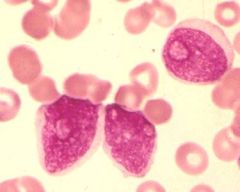
.
|

Acute Leukemia (can't tell which kind) with blasts that have high N:C ratios, round or irregular nuclei, fine chromatin, 1-3 prominant nucleoli, and a moderate amount of blue-grey cytoplasm.
|
|
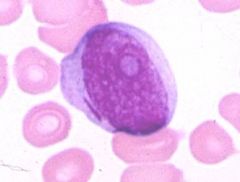
.
|

Acute:
Note the presence of the Auer Rod, which means this is AML |
|
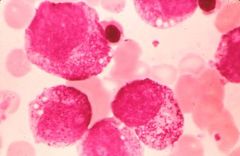
.
|

Acute Leukemia (can't tell which kind) with blasts that have high N:C ratios, round or irregular nuclei, fine chromatin, 1-3 prominant nucleoli, and a moderate amount of blue-grey cytoplasm.
|
|
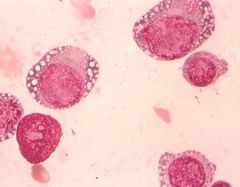
.
|

Acute Leukemia with blasts that have high N:C ratios, round or irregular nuclei, fine chromatin, 1-3 prominant nucleoli, and a moderate amount of blue-grey cytoplasm.
ALL (L3, Burkitt-like) has large cells with strongly basophilic cytoplasm and VACUOLES. L3 is aggressive. |
|
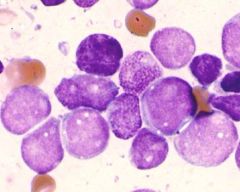
.
|

Acute Leukemia (can't tell which kind) with blasts that have high N:C ratios, round or irregular nuclei, fine chromatin, 1-3 prominant nucleoli, and a moderate amount of blue-grey cytoplasm.
|
|
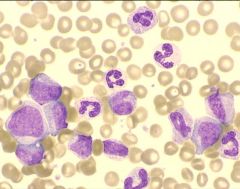
.
|

Peripheral Blood Granulocytosis with "Left Shift" (meaning increased presence of granulocyte precursors): usually means CML.
|
|
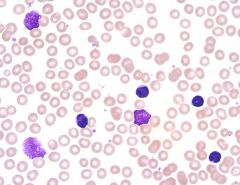
.
|

CLL:
Peripheral smear showing overabundance of small lymphocytes with round nuclei, densely clumped chromatin, no nucleoli and small amount of cytoplasm (opposite of AML's blast cells). Also see "smudge cells", which are remnants of lymphocyte nucleoli that occur as a result of fragile leukemic cells bursting when the smear is prepared. |
|
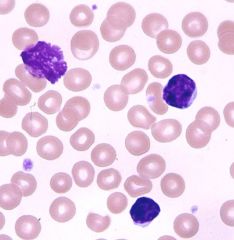
.
|

CLL:
Peripheral smear showing overabundance of small lymphocytes with round nuclei, densely clumped chromatin, no nucleoli and small amount of cytoplasm. Also see "smudge cells", which are remnants of lymphocyte nucleoli that occur as a result of fragile leukemic cells. Aggressive disease associated with CD38, ZAP-70, and unmutated heavy chain variable region. |
|
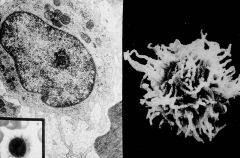
.
|

Hairy Cell leukemia
TRAP pancytopenia |
|

.
|

AML Auer Rod
|
|
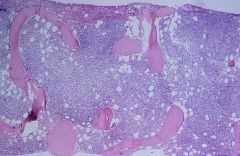
.
|

CLL:
Hypercellular BM causes marrow-replacement anemia. Another source of anemia in CLL is autoimmune hemolytic anemia from the IgG secreted by the leukemic B-cells. |
|
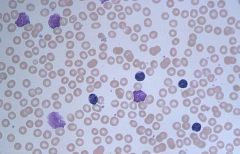
.
|

CLL:
Peripheral smear showing overabundance of small lymphocytes with round nuclei, densely clumped chromatin, no nucleoli and small amount of cytoplasm (opposite of AML's blast cells). Also see "smudge cells", which are remnants of lymphocyte nucleoli that occur as a result of fragile leukemic cells bursting when the smear is prepared. |
|
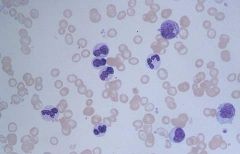
.
|

CML "Left Shift":
The presence of immature granulocyte precursors in the peripheral blood is called "left shift", and is classic for CML. To confirm diagnosis, check for a low LAP score, and presence of t(9;22), BCR/ABL gene. |
|

.
|
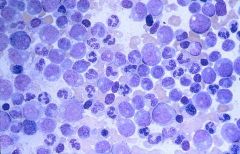
CML:
Presence of all stages of granulocyte precursor cells makes this different from AML. The # of granulocyte maturation stages in the BM will be identical to that in the peripheral blood. Also see abundant Megakaryocytes, often seen in chronic myeloproliforative disorders. |

